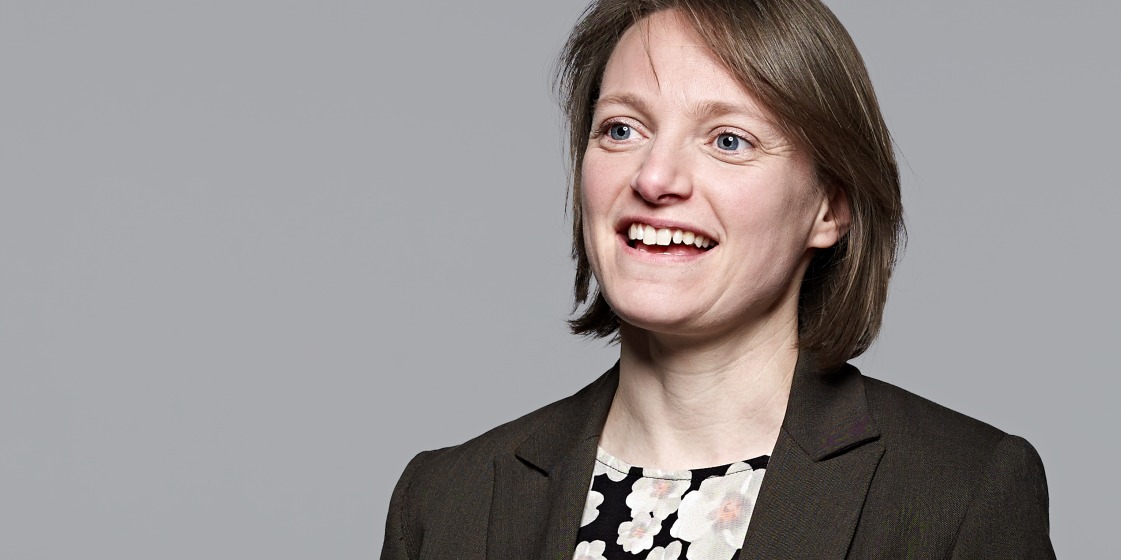
Opinion
The holy grail of fundraising?
by Rosie Dale - 5 October 2016
Associate Partner, Rosie Dale, shares her insights and top tips on mid-value donor programmes, drawing on her up-to-date analysis of More Partnership’s award-winning Regular Giving Benchmarking project.
There’s a lot being written and said about mid-value donors at the moment. For many charities that’s those who give gifts of £1,000 or more. It’s as if mid-value donors are becoming the solution to the fundraising world’s problems. Roger Craver of fundraising blog ‘The Agitator’ predicted that mid-value giving would be a “bonanza” that will top monthly giving and there have been a number of webinars and blog posts written on the subject recently. In a world where constant approaches for small sums is under the spotlight and relationship fundraising is the much talked about answer to the charity sector’s troubles, mid-value fundraising seems like a bit of a holy grail.
An increasing focus on mid-value giving with notable results
The good news is that some universities have been doing this for a while and there are some pretty established mid-value giving programmes in universities across the country. From these programmes, some trends and strategies for success are emerging. These learnings can be applied beyond higher education fundraising and into mid-value giving programmes across the charitable sector.
Over the last five years in particular universities have invested more in this area – and teams and focus have been directed towards building relationships with current and prospective donors giving at this level. Data from this year’s More Partnership Regular Giving Benchmarking, which analyses sub-£10k giving to universities, shows that the number of donors making gifts of between £1k-£10k per annum has increased by 142% since 2010. Not surprisingly those institutions that have invested in this area are also raising more money. The six universities raising the most had increased the amount of income they received from donors giving between £1k-£10k per annum by 202% in the past five years. This compares to an increase of just 56% for the institutions in the study that had invested and focused less in this area.
Data from this study also shows that in the latest year overall donor numbers have plateaued - increasing by 1% compared to a 9% increase in the previous year and an average of 9% in each of the five years previously. Evidence perhaps that there has been a shift towards universities concentrating more resource on how much donors give rather than the number of donors giving.
This is backed up by data from the latest Ross-CASE survey, which similarly reports only a 1.6% increase in donor numbers overall and concludes that there seems to be “an emerging trend of larger gifts coming from a relatively flat number of donors”.
Don’t forget about direct mail
Successful mid-value programmes commonly have small teams of dedicated fundraisers who meet potential donors in person, develop and grow personal relationships with them and, in an ideal world, move them out of mid-value and into major gifts. As the following charts show, gifts solicited in person (face-to-face) account for 52% of all £1k-£10k giving income.
But in the best mid-value programmes, targeted direct marketing works alongside face-to-face approaches to acquire, steward and retain donors. Further analysis from 2014-15 shows that 58% of all £1k-£10k single cash gifts were brought in through direct mail – the largest single source of gifts of this type.
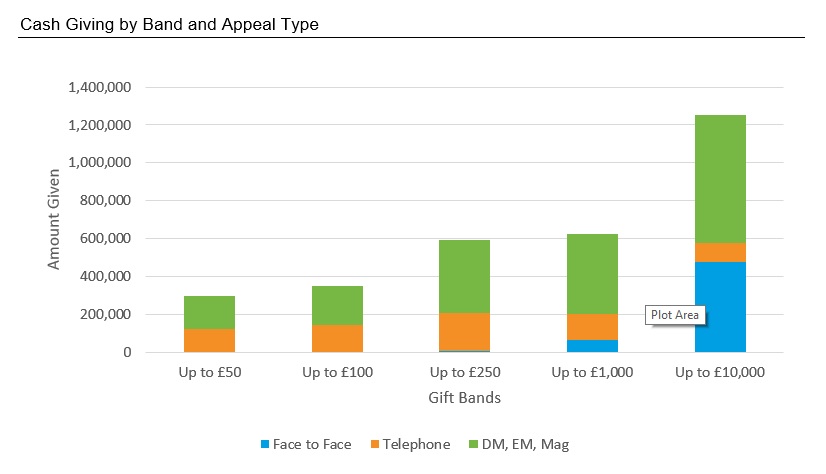
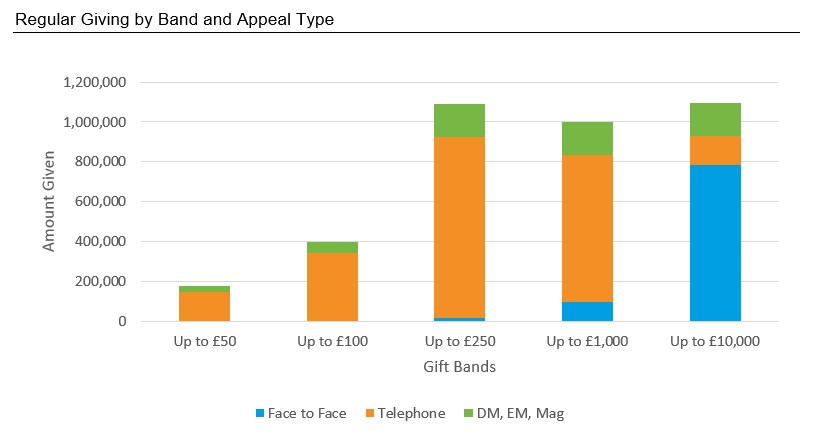
In addition to bespoke direct mail packs, direct marketing strategies such as increased and more segmented stewardship, gift clubs, recognition in donor reports, mid-value donor stories, insider emails from university leaders, higher value ask prompts and targeted telephone calls are employed to grow mid-value giving alongside face-to-face approaches.
What are the challenges?
But the story isn’t all rosy. Although institutions have been successful at recruiting more donors at this level, these programmes do come with their own problems. As mid-value income grows a smaller handful of donors are responsible for a larger proportion of income. Benchmarking data shows that 44% of total sub-£10k income in 2014-15 was given by just 3% of donors who each gave between £1k-£10k per annum. This has increased from 29% of income from donors in this bracket five years ago.
And, as the chart illustrates, because a bigger proportion of £1k-£10k donors make their gifts via cash rather than direct debit, retaining them and the value of the gifts they give, becomes increasingly important to maintaining the overall income of the programme. With increased income from this group has come increased risk to that overall income.
But our findings show that retention rates for mid-value donors are not good. The charts below illustrate the value retention of single (cash) and regular (direct debit) donors giving in different gift bands. This takes the value of giving in any one year and gift band and displays the proportion of that value given by the same people in the next year. If they give more in total (because of upgraded giving), then the value retention figure will be greater than 100%. But if they give less, or drop out of giving, then the value retention figure will be less than 100%. The charts clearly show that, despite some improvements in cash retention in recent years, value retention for donors giving in the £1k-£10k band are the lowest of all donors.
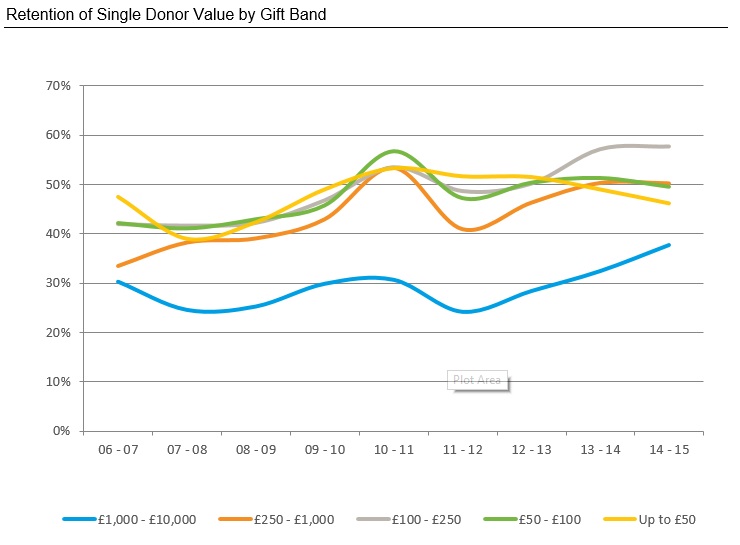
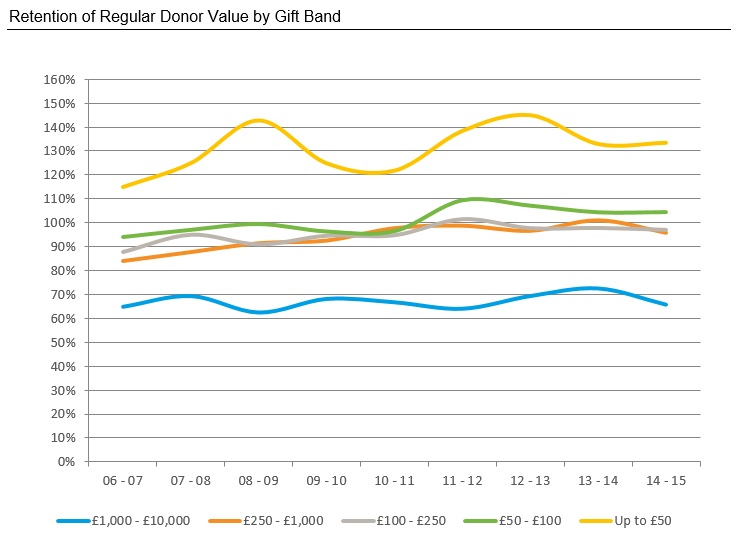
If not addressed these poor retention rates could make maintaining income levels and enhancing donor relationships increasingly difficult. In turn this puts at risk the future funding of programmes that rely on predictable, repeatable income.
So why are retention rates so poor for these donors? After all mid-value donor programmes practice what everyone says donors need more of – donor-centric and personalised relationship building communications. The danger is that these donors are most likely caught between two worlds - the direct marketing dominated world of mass individual giving and the one-to-one relationship building world of major gifts. Both approaches working together are needed to grow and build a successful mid-value giving programme, but tensions often arise between the two. On the one hand direct marketing approaches can fail to be personal or bespoke enough for mid-value donors, whereas on the other hand the priority for much larger gifts can mean mid-value donors are neglected by resource-stretched and target driven face-to-face fundraisers who have to pursue bigger fish.
Although on the surface mid-value donors might seem like a holy grail, these programmes need careful thought, leadership, direction and focus to resolve these issues with strong collaboration across fundraising teams an essential ingredient for success.
And we shouldn’t ignore the fact that if you look a little closer at the charts you’ll also see that there’s a considerable amount of income coming from the £250-£1k income bracket – 28% of total income from just 9% of donors. And many more of these donors give by direct debit, making retention rates far better. So although many universities’ mid-value giving programmes start at £1k we mustn’t ignore the loyal, committed donors giving just below this level - because many of them are likely to be the mid-value donors of the future.
What does all of this mean for fundraisers?
So if you're running a mid-value programme, or thinking of starting one, here are three key things to think about:
To discuss how we can help your charity start or grow its mid-level giving programme or to find out about joining our Regular Giving Benchmarking project, please contact Adrian at abeney@morepartnership.com.